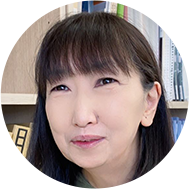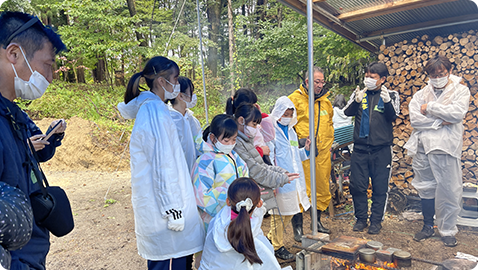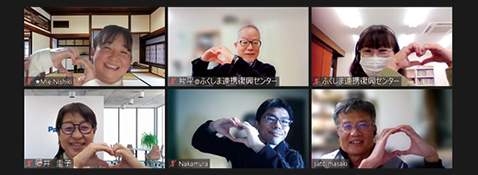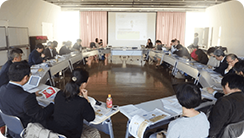An intermediary support organization for Fukushima Prefecture reconstruction and disaster-stricken victims
Aiming to strengthen and expand new networks in and outside of Fukushima Prefecture
An intermediary support organization for Fukushima Prefecture reconstruction and disaster-stricken victims
Aiming to strengthen and expand new networks in and outside of Fukushima Prefecture
The General Incorporated Association Fukushima Cooperative Reconstruction Center
The General Incorporated Association Fukushima Cooperative Reconstruction Center

The “Fukushima Cooperative Reconstruction Center,” an intermediary support organization, is working with other support organizations in and outside of Fukushima Prefecture to provide assistance to disaster-stricken victims. In order to continue to provide much-needed support even 12 years after the Great East Japan Earthquake and Tsunami, a Pro Bono team of Panasonic employees created promotional material for the organization to build a new network. In this issue, we will explain the process.
The “Fukushima Cooperative Reconstruction Center,” an intermediary support organization, is working with other support organizations in and outside of Fukushima Prefecture to provide assistance to disaster-stricken victims. In order to continue to provide much-needed support even 12 years after the Great East Japan Earthquake and Tsunami, a Pro Bono team of Panasonic employees created promotional material for the organization to build a new network. In this issue, we will explain the process.
30,000 People Still Living in Evacuated State In and Outside of Fukushima Prefecture.
Consultation Services at 26 Locations Nationwide
30,000 People Still Living in Evacuated State In and Outside of Fukushima Prefecture.
Consultation Services at 26 Locations Nationwide
March 11 will mark 12 years since the 2011 Great East Japan Earthquake and the Fukushima Daiichi Nuclear Power Plant accident. About 337 km2, or about 2.4% of Fukushima Prefecture, is still considered a “difficult-to-return zone,” and nearly 30,000 people have been evacuated in and out of Fukushima Prefecture.
In response to this, the “Fukushima Cooperative Reconstruction Center” began providing support to disaster victims in July 2011. According to Ms. Rikako Suzuki, Deputy Director of the organization, the Center was established as an intermediary support organization to coordinate external support, in cooperation with the Fukushima University Research Institute for Disaster Recovery and NPOs in and outside of Fukushima Prefecture.
Ms. Suzuki said, “We started off by surveying the environment of temporary housing and monitoring the residents, and now have established 26 centers (consultation offices) not only in Fukushima Prefecture but also in 26 locations throughout Japan to support the reconstruction of the lives of evacuees who are dispersed widely.
March 11 will mark 12 years since the 2011 Great East Japan Earthquake and the Fukushima Daiichi Nuclear Power Plant accident. About 337 km2, or about 2.4% of Fukushima Prefecture, is still considered a “difficult-to-return zone,” and nearly 30,000 people have been evacuated in and out of Fukushima Prefecture.
In response to this, the “Fukushima Cooperative Reconstruction Center” began providing support to disaster victims in July 2011. According to Ms. Rikako Suzuki, Deputy Director of the organization, the Center was established as an intermediary support organization to coordinate external support, in cooperation with the Fukushima University Research Institute for Disaster Recovery and NPOs in and outside of Fukushima Prefecture.
Ms. Suzuki said, “We started off by surveying the environment of temporary housing and monitoring the residents, and now have established 26 centers (consultation offices) not only in Fukushima Prefecture but also in 26 locations throughout Japan to support the reconstruction of the lives of evacuees who are dispersed widely.

Ms. Rikako Suzuki, Deputy Director, the General Incorporated Association Fukushima Cooperative Reconstruction Center
Ms. Rikako Suzuki, Deputy Director, the General Incorporated Association Fukushima Cooperative Reconstruction Center
In cooperation with NPOs in each region, we handle approximately 1,000 consultations annually. In the beginning, many people asked what support measures were available, but as time has passed, more people are consulting with us about the problems associated with their daily lives. Evacuation orders have been lifted in parts of Futaba Town and Okuma Town, which are designated as ‘special reconstruction areas.’ In reality, however, the situation is still far from restoring a secure life. We sometimes receive inquiries about the town’s status from people who are thinking of returning.”
In Fukushima Prefecture, where evacuations were prolonged as a result of the Fukushima Daiichi Nuclear Power Plant accident, the number of deaths related to the subsequent evacuation was 2,333, which was more than the 1,614 deaths directly caused by the earthquake and tsunami. Ms. Suzuki said, “Furthermore, with the major earthquakes in February 2021 and March 2022, and the damage to the coastal areas, combined with the Coronavirus pandemic, mental health care has become increasingly important.”
The reconstruction period, which was originally scheduled to end 10 years after the earthquake and tsunami, is now expected to continue through FY2025 with the establishment of the “Second Reconstruction and Revitalization Period.” Up to now, the Fukushima Cooperative Reconstruction Center has been supporting and building networks with organizations that provide direct support to disaster victims, mainly through projects commissioned by the national and prefectural governments.
However, with the end of the reconstruction budget in sight, the organization has shifted its focus to “activities to create a system to comprehensively look after residents in the local community in cooperation with people from various sectors, including public agencies and private organizations.”
Ms. Suzuki also said, “We had already established relationships with various organizations, but we did not have the promotional material to explain our profile and the significance of our existence in an easy-to-understand manner to the government agencies, companies, and universities with which we wanted to establish relationships. So, we decided to ask Panasonic’s Pro Bono team to help us.”
In cooperation with NPOs in each region, we handle approximately 1,000 consultations annually. In the beginning, many people asked what support measures were available, but as time has passed, more people are consulting with us about the problems associated with their daily lives. Evacuation orders have been lifted in parts of Futaba Town and Okuma Town, which are designated as ‘special reconstruction areas.’ In reality, however, the situation is still far from restoring a secure life. We sometimes receive inquiries about the town’s status from people who are thinking of returning.”
In Fukushima Prefecture, where evacuations were prolonged as a result of the Fukushima Daiichi Nuclear Power Plant accident, the number of deaths related to the subsequent evacuation was 2,333, which was more than the 1,614 deaths directly caused by the earthquake and tsunami. Ms. Suzuki said, “Furthermore, with the major earthquakes in February 2021 and March 2022, and the damage to the coastal areas, combined with the Coronavirus pandemic, mental health care has become increasingly important.”
The reconstruction period, which was originally scheduled to end 10 years after the earthquake and tsunami, is now expected to continue through FY2025 with the establishment of the “Second Reconstruction and Revitalization Period.” Up to now, the Fukushima Cooperative Reconstruction Center has been supporting and building networks with organizations that provide direct support to disaster victims, mainly through projects commissioned by the national and prefectural governments.
However, with the end of the reconstruction budget in sight, the organization has shifted its focus to “activities to create a system to comprehensively look after residents in the local community in cooperation with people from various sectors, including public agencies and private organizations.”
Ms. Suzuki also said, “We had already established relationships with various organizations, but we did not have the promotional material to explain our profile and the significance of our existence in an easy-to-understand manner to the government agencies, companies, and universities with which we wanted to establish relationships. So, we decided to ask Panasonic’s Pro Bono team to help us.”

“Hometown meetings” to communicate the attractiveness of the region to young people
“Hometown meetings” to communicate the attractiveness of the region to young people

Regular activity debriefing by recovery support staff
Regular activity debriefing by recovery support staff
Proposed Two Types of Promotional Material to Boost the Organization’s Activities“SWOT
Analysis” Based on Interviews with Stakeholders
Proposed Two Types of Promotional Material to Boost the Organization’s Activities“SWOT
Analysis” Based on Interviews with Stakeholders
Upon receiving the request, the five-member Pro Bono team conducted a series of interviews with the organization’s stakeholders beginning in July 2022, analyzed the social background, roles, and challenges surrounding the organization, and prepared two types of promotional material. The deliverables were submitted as a final proposal online to the Fukushima Cooperative Reconstruction Center on December 22, 2022.
In the first proposal, the Pro Bono team provided background information by using data on the organization’s establishment as an intermediary support organization in response to the need for collaborative support, the social context of the declining birthrate, aging population, and depopulation, which made reconstruction difficult, and the organization’s goal of rebuilding the local community, as well as the activities, issues, and requests for citizen participation to accomplish this objective.
Upon receiving the request, the five-member Pro Bono team conducted a series of interviews with the organization’s stakeholders beginning in July 2022, analyzed the social background, roles, and challenges surrounding the organization, and prepared two types of promotional material. The deliverables were submitted as a final proposal online to the Fukushima Cooperative Reconstruction Center on December 22, 2022.
In the first proposal, the Pro Bono team provided background information by using data on the organization’s establishment as an intermediary support organization in response to the need for collaborative support, the social context of the declining birthrate, aging population, and depopulation, which made reconstruction difficult, and the organization’s goal of rebuilding the local community, as well as the activities, issues, and requests for citizen participation to accomplish this objective.

Mr. Yoshinori Katahira, Executive Director, the General Incorporated Association Fukushima Cooperative Reconstruction Center
Mr. Yoshinori Katahira, Executive Director, the General Incorporated Association Fukushima Cooperative Reconstruction Center
The second proposal includes a graphic representation of the specific results of the organization’s newly initiated “comprehensive support in the local community.” As an example of network formation, the Pro Bono team first described the structure of the “Fukushima Support Net for People in Need.” In this initiative, major supermarkets set up food bank boxes in their stores, and registered organizations distributed the donated food to those in need. As an example of the organization’s efforts to provide companionship and support, the Pro Bono team Introduced the “Parent-Child Experience Program” initiated by resident volunteers in Kawauchi Village, Futaba County, which includes backcountry mountain experiences, taro stew, barbeques, and other activities. This activity has now become a model project involving school officials and organizations that support after-school care for children, and they are considering expanding the project to other municipalities.
“The first proposal will enable us to explain the overview of our activities and their objectives clearly,” said Mr. Yoshinori Katahira, Executive Director of the Fukushima Cooperative Reconstruction Center, who received the two proposals. “The second proposal will allow us to provide specific examples of our activities. We would like to use them depending on the situation.”
Following the proposals, the Pro Bono team presented the results of a “SWOT analysis,” which analyzed the environment surrounding the organization from the four elements of “strengths, weaknesses, opportunities, and threats,” based on interviews with relevant parties inside and outside the organization. The analysis revealed that “although the organization has connections with NPOs and local governments in the disaster-stricken areas and outside of Fukushima Prefecture, its strengths, and attractiveness have not been fully communicated to the public due to its weak information dissemination capabilities.” At the same time, the analysis indicated that “the organization could provide opportunities for civic engagement for employees of companies that are considering support measures for social issues.”
The second proposal includes a graphic representation of the specific results of the organization’s newly initiated “comprehensive support in the local community.” As an example of network formation, the Pro Bono team first described the structure of the “Fukushima Support Net for People in Need.” In this initiative, major supermarkets set up food bank boxes in their stores, and registered organizations distributed the donated food to those in need. As an example of the organization’s efforts to provide companionship and support, the Pro Bono team Introduced the “Parent-Child Experience Program” initiated by resident volunteers in Kawauchi Village, Futaba County, which includes backcountry mountain experiences, taro stew, barbeques, and other activities. This activity has now become a model project involving school officials and organizations that support after-school care for children, and they are considering expanding the project to other municipalities.
“The first proposal will enable us to explain the overview of our activities and their objectives clearly,” said Mr. Yoshinori Katahira, Executive Director of the Fukushima Cooperative Reconstruction Center, who received the two proposals. “The second proposal will allow us to provide specific examples of our activities. We would like to use them depending on the situation.”
Following the proposals, the Pro Bono team presented the results of a “SWOT analysis,” which analyzed the environment surrounding the organization from the four elements of “strengths, weaknesses, opportunities, and threats,” based on interviews with relevant parties inside and outside the organization. The analysis revealed that “although the organization has connections with NPOs and local governments in the disaster-stricken areas and outside of Fukushima Prefecture, its strengths, and attractiveness have not been fully communicated to the public due to its weak information dissemination capabilities.” At the same time, the analysis indicated that “the organization could provide opportunities for civic engagement for employees of companies that are considering support measures for social issues.”
An Easy-To-Understand Graphical Representation of the Organization’s Roles.Material That Provides a Comprehensive Picture of the Organization
An Easy-To-Understand Graphical Representation of the Organization’s Roles.Material That Provides a Comprehensive Picture of the Organization
After receiving a series of proposals, Mr. Katahira, Executive Director, said, “It must have been a daunting task to describe the role of an intermediary support organization in the promotional material. However, by using this documentation, we will be able to present a complete picture of our organizational activities to people who have some familiarity with them. There were harsh views expressed during the interviews, but we are now aware that we must compensate for our organization’s weaknesses and capitalize on our strengths.” Ms. Suzuki, Deputy Director, showed her appreciation, saying, “I was in Minamisoma at the time of the earthquake, so I am involved in the activities both as a victim and a supporter. Reading the material, I felt that the ‘description of our role’ was so precise that I could find the answers I was looking for in these diagrams!”
Mr. Nobuyuki Nakamura, who participated in the Pro Bono project for the first time, said, “I was in Tokyo at the time of the earthquake and subsequent tsunami, and I have always regretted that I could not do anything for the recovery effort. My participation in the Pro Bono project made me realize once again that we are able to live a normal life thanks to the organizations and people who support society through these kinds of activities.” Ms. Keiko Fujii, who began her Pro Bono project by asking what an intermediary support organization is, emphasizes the importance of the organization, saying, “I realized that small organizations were able to provide their support that would not have been possible without the intermediary of the Fukushima Cooperative Reconstruction Center.”
And lastly, Mr. Masaki Sato, the Pro Bono’s project manager and a resident of Fukushima Prefecture, sent his support to the organization, saying, “I really felt that reconstruction is still in progress. There must be many people who want to support Fukushima Prefecture. I hope that the organization will communicate the attractiveness and challenges of Fukushima Prefecture to recruit supporters.”
After receiving a series of proposals, Mr. Katahira, Executive Director, said, “It must have been a daunting task to describe the role of an intermediary support organization in the promotional material. However, by using this documentation, we will be able to present a complete picture of our organizational activities to people who have some familiarity with them. There were harsh views expressed during the interviews, but we are now aware that we must compensate for our organization’s weaknesses and capitalize on our strengths.” Ms. Suzuki, Deputy Director, showed her appreciation, saying, “I was in Minamisoma at the time of the earthquake, so I am involved in the activities both as a victim and a supporter. Reading the material, I felt that the ‘description of our role’ was so precise that I could find the answers I was looking for in these diagrams!”
Mr. Nobuyuki Nakamura, who participated in the Pro Bono project for the first time, said, “I was in Tokyo at the time of the earthquake and subsequent tsunami, and I have always regretted that I could not do anything for the recovery effort. My participation in the Pro Bono project made me realize once again that we are able to live a normal life thanks to the organizations and people who support society through these kinds of activities.” Ms. Keiko Fujii, who began her Pro Bono project by asking what an intermediary support organization is, emphasizes the importance of the organization, saying, “I realized that small organizations were able to provide their support that would not have been possible without the intermediary of the Fukushima Cooperative Reconstruction Center.”
And lastly, Mr. Masaki Sato, the Pro Bono’s project manager and a resident of Fukushima Prefecture, sent his support to the organization, saying, “I really felt that reconstruction is still in progress. There must be many people who want to support Fukushima Prefecture. I hope that the organization will communicate the attractiveness and challenges of Fukushima Prefecture to recruit supporters.”

The Pro Bono Team members
and the Fukushima Cooperative Reconstruction Center staff after the final proposal
The Pro Bono Team members
and the Fukushima Cooperative Reconstruction Center staff after the final proposal
The General Incorporated Association Fukushima Cooperative Reconstruction Center
The General Incorporated Association Fukushima Cooperative Reconstruction Center

As an intermediary support organization, Fukushima Cooperative Reconstruction Center supports the activities of NPOs and other organizations working to resolve issues facing Fukushima Prefecture so that they can play a proactive role in the community through collaboration and cooperation. It has formed a member network of 160 organizations, companies, and individuals involved in Fukushima Prefecture’s reconstruction and regional revitalization and is active in a variety of fields.
As an intermediary support organization, Fukushima Cooperative Reconstruction Center supports the activities of NPOs and other organizations working to resolve issues facing Fukushima Prefecture so that they can play a proactive role in the community through collaboration and cooperation. It has formed a member network of 160 organizations, companies, and individuals involved in Fukushima Prefecture’s reconstruction and regional revitalization and is active in a variety of fields.


